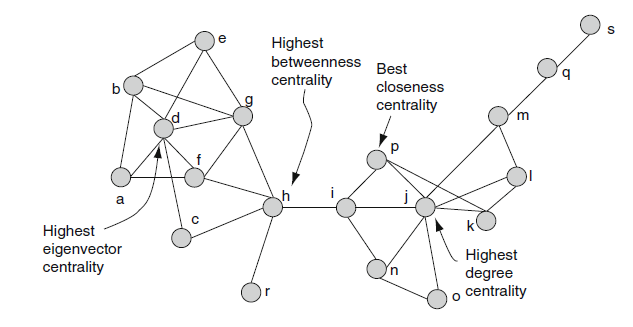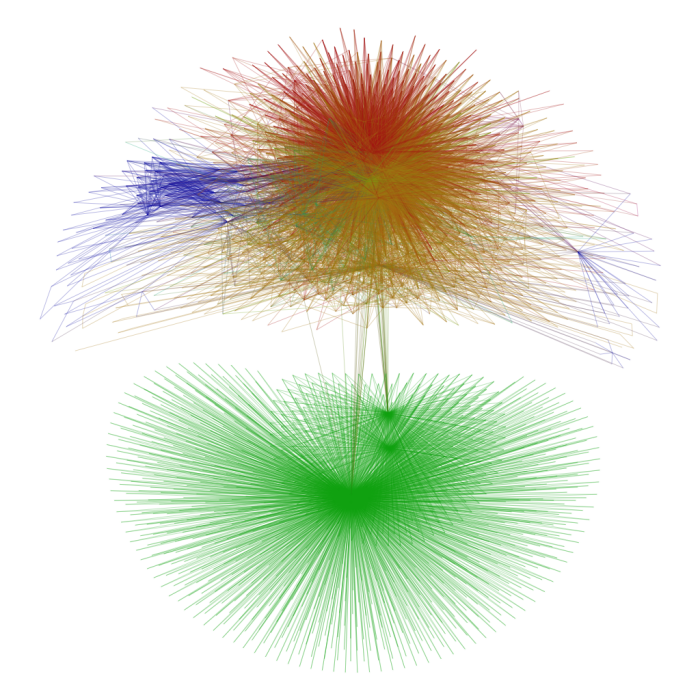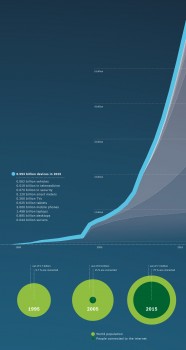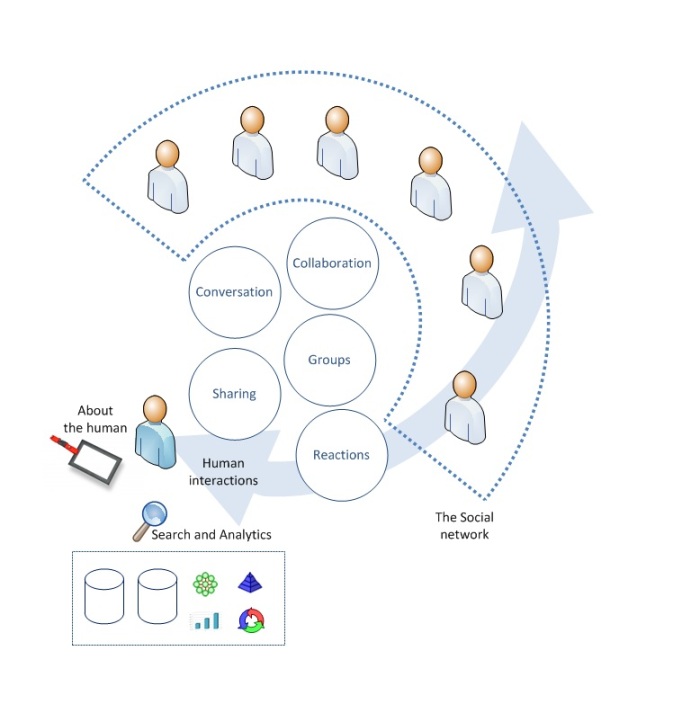On part 1, I introduced the importance of social network understanding as the socialization of interactions is becoming a new working habit and as such classic control flow perspective analysis does not anymore provide information about how work is done.
On this post, I will explore important points to look for when performing Social Network Analysis (SNA).
On properties:
Social networks have typically the following properties:
- Emergence: agents that belong to the network interact in an apparently random way. This feeling is amplified if there are many agents and / or there are too many interactions that make difficult to extract patterns. Emergence is all about separating the signal form the noise and make those patterns to emerge.
- Adaptation: enterprises, communities, exist confined in a particular environment that when changes it makes agents to react. Environment can be external, interaction with customers, suppliers, government agencies; influence like the publication of a new law or regulation or competitor movements as they enter in new markets or create new products or services. Environment can also be internal and its related to the way agents interact that is ultimately associated with how business processes were designed, how IT solutions were deployed, culture, hierarchy configuration and formal recognition of authority, just to provide some examples.
- Variety: Ashby, one of the father’s of cybernetics, defined the Law of Requisite Variety “variety absorbs variety, defines the minimum number of states necessary for a controller to control a system of a given number of states.” For an organisation, to be viable it must be capable of coping with the variety (complexity) of the environment in which it operates. Managing complexity is the essence of a manager’s activity. Controlling a situation means being able to deal with its complexity, that is, its variety [1].
- Connectivity: The way agents are connected and how those connections are aligned with the process type that was designed / being executed and the type of knowledge that is necessary to support operations (more about this alignment here). The existing connections will unveil the emergent patterns that are necessary to identify and understand behaviour under a social point of view (high coupling or loosely coupling between agents or group of agents).
On network types:
Most of the times when people refer to social networks they are expressing their beliefs on community networks like Facebook, subject expert groups like enterprise wikis. Although those are important network types, they do not express the nature of organization operations, because they do not record communication acts expressed on social activity, hence I will only concentrate on Coordination Networks.
A Coordination Network is a network formed by agents related to each other by recorded coordination acts.
Coordination acts are for example, the interchange of emails, tasks as design on enterprise systems or activity streams just to provide some examples. The above definition is an adaptation of [2] because it does not include the importance of coordination act that is related with the nature of work, rather the connection itself. The former is the important dimension related with business process management and will guide the remaining content.
Coordination acts is meant to be as defined (adapted) [3] an act to be performed by one agent, directed to other agent that contains an intention (request, promise, question, assertion) and a proposition (something that is or could be the case in the social world). In the intention, the agent proclaims its social attitude with respect to the proposition. In the proposition, the agent proclaims the fact and the associated time the intention is all about, recorded by the system, supporting the definition Coordination networks, which configuration that can ultimately be discovered, patterns emerge, using discovering techniques like for example process mining.
On analysis dimensions:
Social network analysis is not new. Actually, the first studies were done around the 50’s of last century. Its refinement stumbled around:
- Degree distribution: study connection number around a node of the network;
- Clustering: groups with connection density larger than average;
- Community discovery: measures alignment of connections regarding organization hierarchy.
There is an immense list of techniques to analyse each one of the above dimensions, that reflects the high maturity level of each method, but he drawback is that SNA analysed on each dimension alone can induce managers in the wrong direction. For example, studying community discovery can be important, because communities are a collection of individuals who are linked or related by some sort of relation. But carrying the analysis without taking into consideration the content of the conversation (coordination act) that drove the creation of the link is absolutely wrong, because the conversation is all about the way we humans work. I tend to disagree with other points of view from other practitioners that conversation does not matter (probably because they were influenced by Gordon Pask), only the network configuration. Conversation (the process) is the matter of study.
Social networks are self-organizing systems, but there are important patterns that emerge from the nature of the coordination acts that can be identified. Despite there are random factors and the type of patterns presented in most of scientific papers are based on graph theory and tend to be very simple compared with the reality (and hence maybe this is one of the reasons they are not taken seriously) it is the only way, as an abstraction, to understand agent behaviour. Pattern recognition is critical to align process type (from structured to unstructured), knowledge domain (simple to chaotic) and network type (central to loosely coupled). In order words, to infer trends and help humans to interact better regarding the role they play in the process ecosystem. Having said that, I would like to invoke Stafford Beer’s on models: “in general we use models in order to learn something about the thing modelled (unless they are just for fun)” [5].
Centrality is used to measure degree distribution. Centrality [2] is described as a process participant, business unit, group (a set of process participants or people) or an enterprise system (do not forget the machines) within the context of a social network. Centrality is also related with discovering the key players in social networks.
Some measures that can be used for Centrality are:
- Degree centrality: calculate how many links a node has regarding the remaining network nodes (commonly called network stars). Higher degree centrality means higher probability of receiving information (but does not mean it drives information flow inside of the network).
- Betweenness: measures the degree witch a process participant controls information flow. They act as brokers. The higher the value, higher is information flow traffic that moves from each node to every other node in the network. The importance of Betweenness in social network analysis is nodes with higher values stop processing coordination acts, will block information flow to run properly.
- Closeness: measures how close a node is isolated in the network compared with other network mode. Nodes with low closeness are able to reach or be reached by most of all other nodes in the network, in other words low closeness means a node is well positioned to receive information early when it has more value. Closeness measure must be supported on time dimension (see reference about the timestamp attribute on the coordination act exemplification), without it, is useless.
- Eigenvector centrality: used to calculate node influence in the network. Higher scores means a node can influence (touch) many other important nodes.
In order o put it all together its worth to consider the following self-explanatory picture [6]:
The challenge:
There is a lot of noise around what is the best measure to perform SNA, as I learned at the User Modelling, Adaptation and Personalization Conference 2011 it’s time to put the mathematical equations aside and practice it’s application.
At this moment of time, there are plenty of ways to measure network centrality, but somehow they neglect that those algorithms are not appropriate regarding the type of business process / information system interaction played. For example, Eigenvector centrality measure is important in unstructured processes, where the path is defined on instance mode and it is necessary to create a team and involve others as the process progress. Once SNA does not analyze the process type, only about agent relation, if applied analyzing a procure to pay process (highly structured process type) it’s useless and can damage results interpretation, because on this case, every agent, every process participant receives and process information basically the same way to achieve the same outcome every same day. Maybe this is the reason why is not yet taken more seriously, because these days the process is all about social interaction and it cannot anymore be analyzed naively taking into consideration the dispersion, complexity and interdependence of relationships, something that can also be applied on IT requirements elicitation or IT system operation , which allows to understand communities interaction in order to support emerging and unique processes under a techno-social systems approach [7].
References:
[1] – Design and Diagnosis for Sustainable Organizations – Jose´ Pérez Ríos – Springer – ISBN 9783642223174
[2] – Large Scale Structure and Dynamics of Complex Networks – Guido Caldarelli; Alessandro Vespignani – World Scientific Publishing – ISBN-139789812706645
[3] – Enterprise Ontology – Jan Dietz – Springer – ISBN – 3540291695
[4] – Complex Adaptive Systems Modeling – A multidisciplinary Roadmap – Muaz A Niazi
[5] – The Brain of the firm – Stafford Beer – Jonh Wiley & Sons – ISBN – 047194839-X
[6] – Discovering Sets of Key Players in Social Networks – Daniel Ortiz-Arroyo – Springer 2010
[7] – José L.R. Sousa, Ricardo J. Machado, J.F.F. Mendes. Modeling Organizational Information Systems Using “Complex Networks” Concepts. IEEE Computer Society 2012, ISBN 978-0-7695-4777





